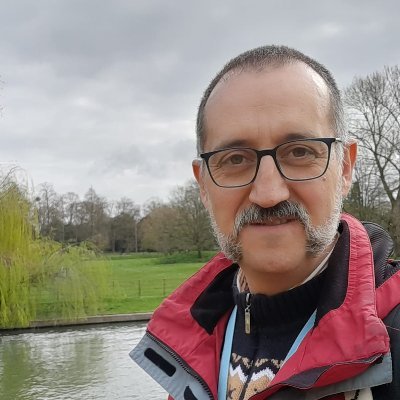|
2020-01 to present: Research Associate. Department of Genetics, University of Cambridge
2020-04 to present: Senior Member (PDRA). St Edmund's College, University of Cambridge
2016-11 to 2019-03: Senior Lecturer. Department of Molecular Biology, Universidad Autonoma de Madrid
2011-09 to 2016-09: Lecturer. Department of Molecular Biology, Universidad Autonoma de Madrid
2008-10 to 2011-09: Visiting Lecturer. Department of Molecular Biology, Universidad Autonoma de Madrid
2009-12 to 2011-08: Assistant Lecturer. Department of Cell Biology, Anatomy and Physiology, Universidad Pablo de Olavide, Sevilla
2006-09 to 2011-08: Research Associate. Centro Andaluz de Biologia del Desarrollo, Sevilla
2003-10 to 2006-08: Research Associate. Institut de Recerca Biomedica, Barcelona
2001-01 to 2003-09: Postdoctoral Fellow. European Molecular Biology Laboratory, Heidelberg
2000-01 to 2000-12: Postdoctoral Fellow. Centro de Biologia Molecular Severo Ochoa, Madrid
1995-09 to 1999-08: Predoctoral Fellow. Centro de Biologia Molecular Severo Ochoa, Madrid
1993-10 to 1995-08: Graduate Student. Centro de Biologia Molecular Severo Ochoa, Madrid
1993-01 to 1993-12: Undergraduate Student. Centro de Biologia Molecular Severo Ochoa, Madrid
1990-10 to 1991-06: Undergraduate Student. Department of Biochemistry, Universidad de Granada
|
Publications
ORCID
Web of Science
Scopus
Google Scholar
A toggle-switch and a feed-forward loop engage in the control of the Drosophila Retinal Determination Gene Network. Sanchez-Aragon M, Cantisan-Gomez J, Luque CM, Bras-Pereira C, Lopes CS, Lemos MC, Casares F. Frontiers in Ecology and Evolution (2019) doi:10.3389/fevo.2019.00221
GTP exchange factor Vav regulates guided cell migration by coupling guidance receptor signalling to local Rac activation. Fernandez-Espartero CH, Ramel D, Farago M, Malartre M, Luque CM, Limanovich S, Katzav S, Emery G, Martin-Bermudo MD. Journal of Cell Science (2013) doi:10.1242/jcs.124438
Coenzyme Q10: A novel therapeutic approach for Fibromyalgia? Case series with 5 patients. Cordero MD, Alcocer-Gomez E, de Miguel M, Cano-Garcia FJ, Luque CM, Fernandez-Riejo P, Fernandez AM, Sanchez-Alcazar JA. Mitochondrion (2011) doi:10.1016/j.mito.2011.03.122
A gain-of-function suppressor screen for genes involved in dorsal-ventral boundary formation in the Drosophila wing. Bejarano F, Luque CM, Herranz H, Sorrosal G, Rafel N, Pham TT, Milan M. Genetics (2008) doi:10.1534/genetics.107.081869.
A role for the chaperone Hsp70 in the regulation of border cell migration in the Drosophila ovary. Cobreros L, Fernandez-Minan A, Luque CM, Gonzalez-Reyes A, Martin-Bermudo MD. Mechanisms of Development (2008) doi:10.1016/j.mod.2008.07.006
Growth control in the proliferative region of the Drosophila eye-head primordium: The elbow-noc gene complex. Luque CM, Milan M. Developmental Biology (2007) doi:10.1016/j.ydbio.2006.07.050
Two distinct modes of guidance signalling during collective migration of border cells. Bianco A, Poukkula M, Cliffe A, Mathieu J, Luque CM, Fulga TA, Rorth P. Nature (2007) doi:10.1038/nature05965.
Of Fat flies and Hippos, or the magic of animal size. Casares F, Luque CM, Tavares MJ. Nature Structural & Molecular Biology (2006) doi:10.1038/nsmb1206-1051.
Regulators of endocytosis maintain localized receptor tyrosine kinase signaling in guided migration. Jekely G, Sung HH, Luque CM, Rorth P. Developmental Cell (2005) doi:10.1016/j.devcel.2005.06.004
The PDGF/VEGF receptor controls blood cell survival in Drosophila. Bruckner K, Kockel L, Duchek P, Luque CM, Rorth P, Perrimon N. Developmental Cell (2004) doi:10.1016/j.devcel.2004.06.007
An alternative domain containing a leucine-rich sequence regulates nuclear cytoplasmic localization of protein 4.1R. Luque CM, Perez-Ferreiro CM, Perez-Gonzalez A, Englmeier L, Koffa MD, Correas I. Journal of Biological Chemistry (2003) doi:10.1074/jbc.M201521200
4.1R proteins associate with interphase microtubules in human T cells: A 4.1R constitutive region is involved in tubulin binding. Perez-Ferreiro CM, Luque CM, Correas I. Journal of Biological Chemistry (2001) doi:10.1074/jbc.M107369200
A constitutive region is responsible for nuclear targeting of 4.1R: modulation by alternative sequences results in differential intracellular localization. Luque CM, Correas I. Journal of Cell Science (2000) url:jcs.biologists.org/content/113/13/2485
The N-terminal 209-aa domain of high molecular-weight 4.1R isoforms abrogates 4.1R targeting to the nucleus. Luque CM, Lallena MJ, Perez-Ferreiro CM, de Isidro Y, De Carcer G, Alonso MA, Correas I. Proceedings of the National Academy of Sciences USA (1999) doi:10.1073/pnas.96.26.14925
An alternative domain determines nuclear localization in multifunctional protein 4.1. Luque CM, Lallena MJ, Alonso MA, Correas I. Journal of Biological Chemistry (1998) doi:10.1074/jbc.273.19.11643
|
